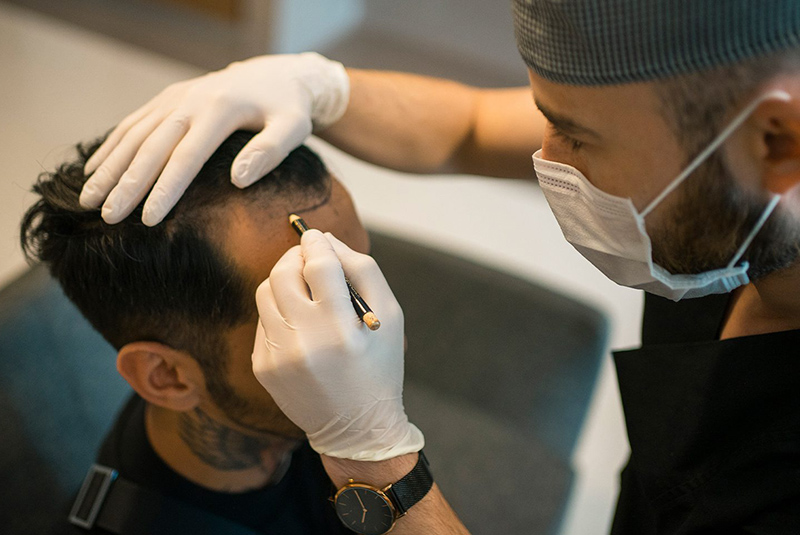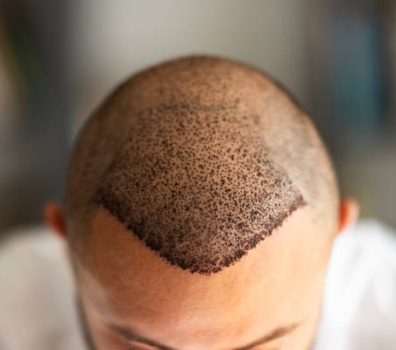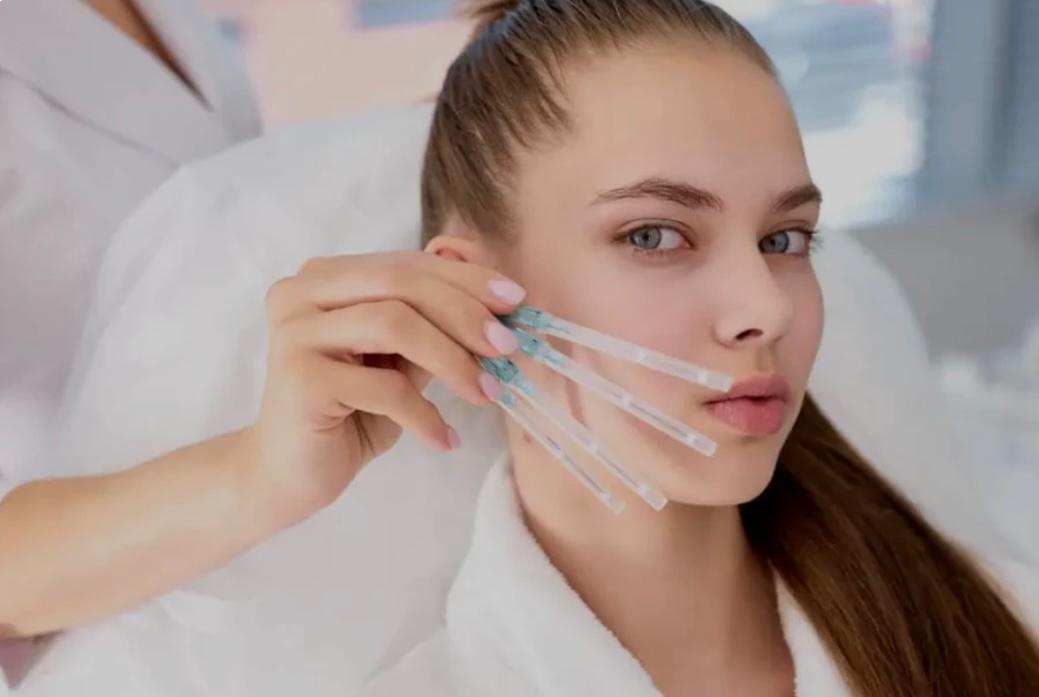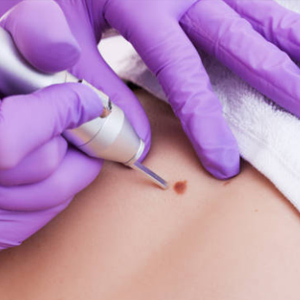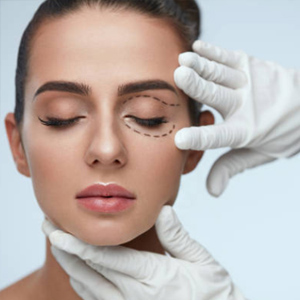Hair Transplant Surgery in Southend On Sea – Essex – UK
The Art of Natural Hair Restoration
Enquire now
The Hair Transplant Procedure: A Step-by-Step Approach
Our Hair Transplant Process: Two Key Phases
1. Extraction of Donor Hairs
We utilize two primary techniques to harvest hair follicles:
Follicular Unit Excision (FUE): This method involves removing individual hair follicles with a precision tool, leaving small, discreet scars that are usually hard to notice. In comparison, FUE is less invasive and offers faster recovery times. As a result, it provides a quicker and more comfortable healing process than other techniques.
Strip Method (FUT): In this technique, a strip of scalp with hair is removed, allowing for the separation of hair follicles. Although this method may leave a straight scar, it can be very effective for some people, especially those needing more grafts.
Both methods have their own benefits, depending on what the patient needs and the results they want to achieve.
During your consultation, our experts will assess your individual needs and recommend the most suitable method based on your hair loss pattern and goals.
2. Designing the Recipient Area and Implanting Grafts
Creating a natural-looking hairline requires precision and artistry. Our team carefully considers factors such as angle, orientation, and density to achieve an aesthetically pleasing result. Together, we will define the recipient area and establish the optimal donor-to-recipient hair ratio, tailored to your unique circumstances.
Please note: The availability of donor hairs may limit coverage or density in larger recipient areas. However, we can plan for additional procedures if desired, keeping future hair loss in mind for ongoing results.
The Hair Transplant Procedure: A Step-by-Step Approach
Our hair transplant process consists of two main phases:
-
- Extraction of Donor Hairs
We utilize two primary techniques to harvest hair follicles:- Follicular Unit Excision (FUE): This method involves extracting individual follicular units using a precision punch tool, resulting in tiny, discreet scars that are often imperceptible.
- Strip Method (FUT): In this technique, a strip of hair-bearing scalp is removed, allowing for the dissection of follicular units. While this method may leave a linear scar, it can be effective for certain candidates.
During your consultation, our experts will assess your individual needs and recommend the most suitable method for you.
- Designing the Recipient Area and Implanting Grafts
Creating a natural-looking hairline requires precision and artistry. Our team focuses on key factors such as angle, orientation, and density to ensure an aesthetically pleasing result. Together, we will define the recipient area and establish an optimal donor-to-recipient hair ratio, taking into account your unique circumstances.
Please note: the availability of donor hairs may limit coverage or density in larger recipient areas. However, we can plan for additional procedures if desired, keeping future hair loss in mind.
- Extraction of Donor Hairs
Recovery and Follow-Up Care: Your Journey to a Fuller Head of Hair
Post-Transplant Recovery and Results Timeline
After your hair transplant, you can expect the following timeline for recovery and results:
- 3 to 4 Months: Initial hair growth begins to emerge.
- 6 to 9 Months: Significant aesthetic improvement becomes evident.
- Up to 18 Months: The quality and fullness of your transplanted hair continue to enhance.
Structured Follow-Up Care
At JR Medical, we prioritize your post-operative care with a structured follow-up schedule:
- 1 Week Post-Procedure: Initial check-up to assess healing and ensure everything is progressing well.
- 1 Month Post-Procedure: Follow-up to evaluate progress, address any concerns, and make any necessary adjustments.
- 3 Months Post-Procedure: Assessment of hair growth and overall results to track improvements.
- 1 Year Post-Procedure: Comprehensive evaluation to ensure long-term satisfaction with the results.
In addition, our team will be there every step of the way to guide you through the recovery process and help you achieve the best possible outcome.
Who Can Benefit from Hair Transplantation?
Hair transplant before and after
Why Choose JR Medical Clinic?
Choosing the right clinic for your hair transplant is crucial. At JR Medical Clinic, we offer exceptional care, outstanding results, and peace of mind every step of the way.
Expert Care with Experienced Doctors
All hair transplants at JR Medical are performed by experienced doctors, ensuring the best outcomes. We guarantee that only qualified professionals handle your procedure, prioritizing your care.
Comprehensive Support on Surgery Day
On the day of your procedure, we provide everything you need for a smooth experience, from preparation to aftercare. Our team ensures you feel at ease for optimal results.
Ongoing Follow-up Care
We schedule follow-up appointments to monitor your progress and ensure you’re on track for the best results. Our team is always here to support you.
24/7 Hotline Support
Our hotline is available 24/7 for any questions or concerns, offering guidance whenever you need it throughout your journey.
Accredited and Trusted
JR Medical Clinic is fully registered with the Care Quality Commission (CQC) and a member of the British Association of Hair Restoration Surgery (BAHRS), reflecting our commitment to high standards of patient care and safety.
Should I go bald or get a hair transplant ?
Shaving can be a quick choice, but it might make you look older or more tired. On the other hand, a hair transplant offers a natural solution. It restores a full head of hair that blends perfectly, helping you look like you never had hair loss in the first place.
When is too late for a hair transplant ?
There’s no set age limit for hair transplants. As long as you’re healthy and have enough donor hair, the procedure is possible. Whether you’re in your twenties or seventies, we can guide you toward restoring your hairline and regaining a youthful appearance.
what is the age limit for hair transplant ?
There’s no set age limit for hair transplants. As long as you’re healthy and have enough donor hair, the procedure is possible. Whether you’re in your twenties or seventies, we can guide you toward restoring your hairline and regaining a youthful appearance.
Can a fully bald person get a hair transplant ?
Are hair transplants worth it ?
One common question about hair transplants is whether they’re worth it. The answer is yes, and here’s why. A hair transplant offers a permanent solution for hair loss, with results that can last a lifetime. Plus, it not only restores hair growth but also improves confidence and enhances overall well-being.
what are the disadvantages of hair transplant ?
Hair transplants have some disadvantages, such as potential side effects like scarring, infection, or unnatural results if not done properly. time-consuming, and requires a recovery period. Additionally, it relies on having sufficient donor hair, which might not be available for everyone.
what celebs have had hair transplants ?
Many celebrities have opted for hair transplants to restore their confidence and maintain their youthful appearance. Famous names like Wayne Rooney, Elon Musk, and John Travolta are known for undergoing hair restoration procedures. Their results highlight how effective modern techniques can be in achieving natural, long-lasting transformations.
